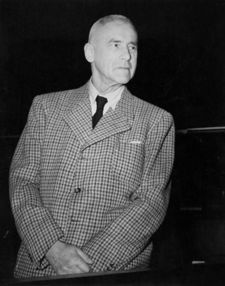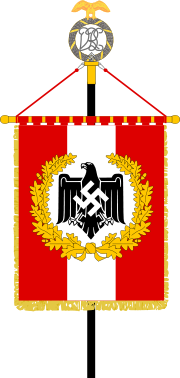Wilhelm Frick
| Wilhelm Frick | |
 |
|
|
Reich Minister of the Interior
|
|
|---|---|
| In office 1933–1943 |
|
| President | Paul von Hindenburg (1933-1934) Adolf Hitler (1934-1943) |
| Chancellor | Adolf Hitler |
| Preceded by | Franz Bracht |
| Succeeded by | Heinrich Himmler |
|
|
|
| In office 24 August 1943 – 4 May 1945 |
|
| Appointed by | Adolf Hitler |
| Preceded by | Konstantin von Neurath (titular) Kurt Daluege (de facto) |
| Succeeded by | Edvard Beneš (President of Czechoslovakia) |
|
|
|
| Born | 12 March 1877 Alsenz, Bavaria, Germany |
| Died | 16 October 1946 (aged 69) Nuremberg, Germany |
| Nationality | German |
| Political party | National Socialist German Workers' Party (NSDAP) |
| Spouse(s) | Elisabetha Emilie Nagel (married 1910, divorced 1934), Margarete Schultze-Naumburg (married 1934) |
| Alma mater | University of Munich University of Göttingen University of Berlin University of Heidelberg |

Wilhelm Frick (12 March 1877 – 16 October 1946) was a prominent German Nazi official serving as Minister of the Interior of the Third Reich. After the end of World War II, he was tried for war crimes at the Nuremberg Trials and executed.
Contents |
Early life and family
Frick was born in Alsenz, Bavaria, Germany, the last of four children of teacher Wilhelm Frick the elder and his wife Henriette (née Schmidt). He was educated in Kaiserslautern and studied jurisprudence at Heidelberg, graduating in 1901. He joined the Bavarian civil service in 1903, working as a lawyer at the police headquarters in Munich. He was made a Bezirksamtassessor in 1907 and rose to the position of Regierungsassessor by 1917.
In 1910, Frick married Elisabetha Emilie Nagel (1890 - 1978) in Pirmasens. They had two sons and a daughter. The marriage ended in an ugly divorce in 1934. Later that year Frick remarried, to Margarete Schultze-Naumburg (1896 - 1960), the former wife of Paul Schultze-Naumburg. Margarete gave birth to a son and a daughter.[1]
Education
Frick finished school in Kaiserslautern. Between 1896 and 1900, he studied at the University of Munich, the University of Göttingen and the University of Berlin and completed his degree in law in Munich. Frick earned a doctor of laws from the University of Heidelberg in 1901.
NSDAP career
Wilhelm Frick joined the NSDAP in September 1925 and worked for an insurance company. He took part in the Beer Hall Putsch (November 1923), at which time he was director of the Munich Kriminalpolizei. He was one of those arrested and imprisoned for the putsch and was tried for treason in April 1924. He was given a suspended sentence of 15 months' imprisonment and was dismissed from his police job. Frick was elected to the Reichstag in May 1924 and associated himself with the radical Gregor Strasser; he climbed to posts of leadership in the NSDAP, becoming Fraktionsführer in 1928.[2]
Wilhelm Frick was appointed Minister of the Interior and of Education in the state government of Thuringia during 1930–31, being the first Nazi to hold any ministerial-level post in pre-Nazi Germany.[3]
When Hitler came to power in January 1933, Frick was appointed Minister of the Interior of the Reich, one of only three Nazis in the original Hitler Cabinet. He initially had far less power than his counterparts in the rest of Europe. For example, he had no authority over the police. In Germany, law enforcement has traditionally been a state and local matter.
Frick's power dramatically increased as a result of the Reichstag Fire Decree and the Enabling Act of 1933. He was responsible for drafting many of the "Gleichschaltung" laws that consolidated the Nazi regime.[4] Under the Law for the Reconstruction of the Reich, which converted Germany into a highly centralized state, the state governors were responsible to him. By 1935, he also had sole power to appoint the mayors of all municipalities with populations greater than 100,000 (except for Berlin and Hamburg, where Hitler reserved the right to appoint the mayors).
Frick was instrumental in passing laws against Jewish people, like the notorious Nuremberg Laws, in September 1935.[2] Frick took a leading part in Germany's re-armament in violation of the Versailles Treaty. He drafted laws introducing universal military conscription and extending the military service law to Austria after the Anschluss, as well as to the annexed regions of Czechoslovakia.[5] In the summer 1938 Wilhelm Frick was named the patron (Schirmherr) of the Deutsches Turn- und Sportfest in Breslau, a patriotic sports festival attended by Hitler and all the Nazi top brass. In this event he presided the ceremony of "handing over" the new Nazi Sports Office standard (Bannerüberführung) to Hans von Tschammer und Osten, marking the further nazification of sports in Germany.[6]
From the mid-to-late 1930s Frick lost favour irreversibly within the Nazi Party after a power struggle involving attempts to resolve the lack of coordination within the Reich government.[7] For example, in 1933 he tried to restrict the widespread use of "protective custody" orders that were used to send people to concentration camps, only to be begged off by SS chief Heinrich Himmler. His power was greatly reduced in 1936 when Hitler named Himmler chief of all German police forces. This effectively united the police with the SS and made it virtually independent of Frick's control, since Himmler was responsible only to Hitler.[8] A long-running power struggle between the two culminated in Frick being replaced by Himmler as interior minister in 1943.
Frick's replacement as Reich interior minister did not reduce, however, the growing administrative chaos and infighting between party and state agencies.[9] Frick was then appointed to the ceremonial post of Protector of Bohemia and Moravia. Prague, the capital of the protectorate, where Frick used ruthless methods to counter dissent, was one of the last Axis-held cities to fall at the end of World War II in Europe.[10]
Trial and execution

Frick was arrested and tried before the International Military Tribunal at Nuremberg, where he was the only defendant besides Rudolf Hess who refused to testify on his own behalf.[11] This for his role in formulating the Enabling Act as Minister of the Interior, the later Nuremberg Laws (as co-author with Wilhelm Stuckart), that led to people under those laws being sent to German concentration camps, Frick was convicted of planning, initiating and waging wars of aggression, war crimes and crimes against humanity. Frick was also accused of being one of the highest persons responsible for the existence of the concentration camps.[5] Wilhelm Frick was sentenced to death on 1 October 1946, and was hanged about two weeks later on 16 October. Of his execution, journalist Howard K. Smith wrote:
- The sixth man to leave his prison cell and walk with handcuffed wrists to the death house was 69-year-old Wilhelm Frick. He entered the execution chamber at 2.05 a.m., six minutes after Rosenberg had been pronounced dead. He seemed the least steady of any so far and stumbled on the thirteenth step of the gallows. His only words were, "Long live eternal Germany," before he was hooded and dropped through the trap.[12][13]
See also
- Glossary of Nazi Germany
- List of Nazi Party leaders and officials
Notes and references
- ↑ Biographie, Wilhelm Frick NS-Politiker
- ↑ 2.0 2.1 Rulers Index
- ↑ Nurnbergprocessen 1
- ↑ Nazi Party organizations, Reich Interior Minister: Wilhelm Frick (1933-1943)
- ↑ 5.0 5.1 Wilhelm Frick (1877-1946)
- ↑ Dr. Frick presiding the Breslau Games
- ↑ A legalistic follower, rather than an initiator, Frick the servant increasingly lost favour with his master, apparently because he misunderstood the basic nature of the Fuhrer's governance. Whereas the Third Reich thrived on inconsistencies, rivalries, and constant evolutionary change, Frick's juristic mind longed for order and legal stabilization. The incongruity was insuperable and it was thus logical enough that in 1943 the minister, whose share of practical power had kept diminishing at a pitiful rate, ultimately even lost his official post.Udo Sautter, Canadian Journal of History
- ↑ As chief of all police forces, Himmler was technically responsible to Wilhelm Frick, the minister of the Interior, but in practice answered only to Hitler.[1]
- ↑ Hans Mommsen, The Dissolution of the Third Reich (1943-1945)
- ↑ Trial:Wilhelm Frick
- ↑ The Avalon Project : Nuremberg Trial Proceedings Vol. 22
- ↑ Howard K. Smith, who witnessed the execution of Wilhelm Frick and nine other leaders of the Nazi Party on 1st October 1946
- ↑ Today, one can see Wilhelm Frick's military dress uniform at Motts Military Museum in Groveport, Ohio. The uniform was found in his home shortly after Frick was arrested in 1945. The soldier who found and brought the items home was a member of the CIC (Counter Intelligence Corps). Richard Roberts was an attorney from Columbus, Ohio who spent the war years in espionage and counter intelligence.
Further reading
| Government offices | ||
|---|---|---|
| Preceded by Konstantin von Neurath |
Protector of Bohemia-Moravia 24 August 1943 – 4 May 1945 |
Abolished |
| Preceded by Kurt Daluege |
||
|
||||||||||||||
|
|||||||||||||||||
|
|||||||||||||||||